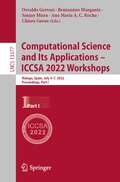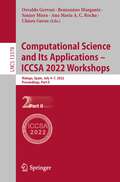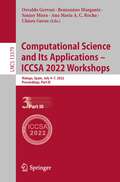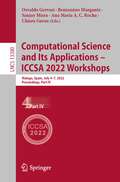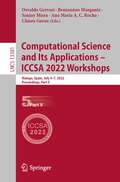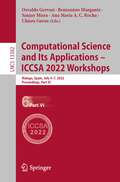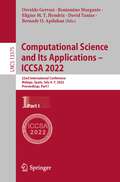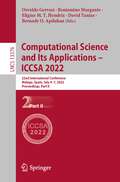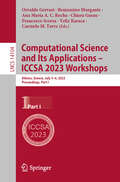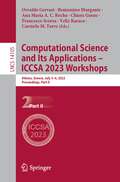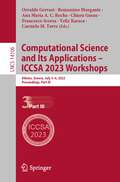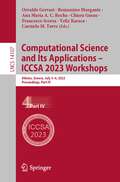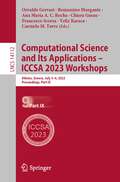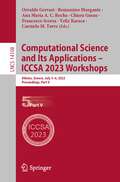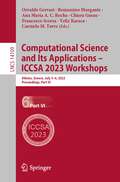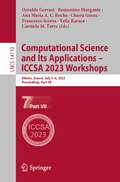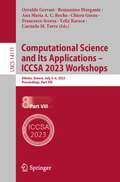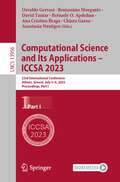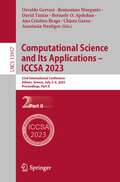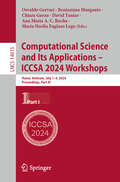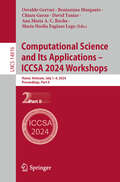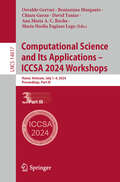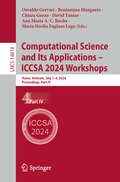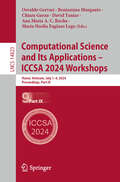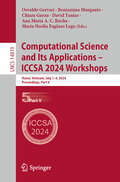- Table View
- List View
Computational Science and Its Applications – ICCSA 2022 Workshops: Malaga, Spain, July 4–7, 2022, Proceedings, Part I (Lecture Notes in Computer Science #13377)
by Osvaldo Gervasi Beniamino Murgante Sanjay Misra Ana Maria A. C. Rocha Chiara GarauThe eight-volume set LNCS 13375 – 13382 constitutes the proceedings of the 22nd International Conference on Computational Science and Its Applications, ICCSA 2022, which was held in Malaga, Spain during July 4 – 7, 2022. The first two volumes contain the proceedings from ICCSA 2022, which are the 57 full and 24 short papers presented in these books were carefully reviewed and selected from 279 submissions. The other six volumes present the workshop proceedings, containing 285 papers out of 815 submissions. These six volumes includes the proceedings of the following workshops:Advances in Artificial Intelligence Learning Technologies: Blended Learning, STEM, Computational Thinking and Coding (AAILT 2022); Workshop on Advancements in Applied Machine-learning and Data Analytics (AAMDA 2022); Advances in information Systems and Technologies for Emergency management, risk assessment and mitigation based on the Resilience (ASTER 2022); Advances in Web Based Learning (AWBL 2022); Blockchain and Distributed Ledgers: Technologies and Applications (BDLTA 2022); Bio and Neuro inspired Computing and Applications (BIONCA 2022); Configurational Analysis For Cities (CA Cities 2022); Computational and Applied Mathematics (CAM 2022), Computational and Applied Statistics (CAS 2022); Computational Mathematics, Statistics and Information Management (CMSIM); Computational Optimization and Applications (COA 2022); Computational Astrochemistry (CompAstro 2022); Computational methods for porous geomaterials (CompPor 2022); Computational Approaches for Smart, Conscious Cities (CASCC 2022); Cities, Technologies and Planning (CTP 2022); Digital Sustainability and Circular Economy (DiSCE 2022); Econometrics and Multidimensional Evaluation in Urban Environment (EMEUE 2022); Ethical AI applications for a human-centered cyber society (EthicAI 2022); Future Computing System Technologies and Applications (FiSTA 2022); Geographical Computing and Remote Sensing for Archaeology (GCRSArcheo 2022); Geodesign in Decision Making: meta planning and collaborative design for sustainable and inclusive development (GDM 2022); Geomatics in Agriculture and Forestry: new advances and perspectives (GeoForAgr 2022); Geographical Analysis, Urban Modeling, Spatial Statistics (Geog-An-Mod 2022); Geomatics for Resource Monitoring and Management (GRMM 2022); International Workshop on Information and Knowledge in the Internet of Things (IKIT 2022); 13th International Symposium on Software Quality (ISSQ 2022); Land Use monitoring for Sustanability (LUMS 2022); Machine Learning for Space and Earth Observation Data (MALSEOD 2022); Building multi-dimensional models for assessing complex environmental systems (MES 2022); MOdels and indicators for assessing and measuring the urban settlement deVElopment in the view of ZERO net land take by 2050 (MOVEto0 2022); Modelling Post-Covid cities (MPCC 2022); Ecosystem Services: nature’s contribution to people in practice. Assessment frameworks, models, mapping, and implications (NC2P 2022); New Mobility Choices For Sustainable and Alternative Scenarios (NEMOB 2022); 2nd Workshop on Privacy in the Cloud/Edge/IoT World (PCEIoT 2022); Psycho-Social Analysis of Sustainable Mobility in The Pre- and Post-Pandemic Phase (PSYCHE 2022); Processes, methods and tools towards RESilient cities and cultural heritage prone to SOD and ROD disasters (RES 2022); Scientific Computing Infrastructure (SCI 2022); Socio-Economic and Environmental Models for Land Use Management (SEMLUM 2022); 14th International Symposium on Software Engineering Processes and Applications (SEPA 2022); Ports of the future - smartness and sustainability (SmartPorts 2022); Smart Tourism (SmartTourism 2022); Sustainability Performance Assessment: models, approaches and applications toward interdisciplinary and integrated solutions (SPA 2022); Specifics of smart cities development in Europe (SPEED 2022); Smart and Sustainable Island Communities (SSIC 2022); Theoretical and Computational Chemistryand its Applications (TCCMA 2022); Transport Infr
Computational Science and Its Applications – ICCSA 2022 Workshops: Malaga, Spain, July 4–7, 2022, Proceedings, Part II (Lecture Notes in Computer Science #13378)
by Osvaldo Gervasi Beniamino Murgante Sanjay Misra Ana Maria A. C. Rocha Chiara GarauThe eight-volume set LNCS 13375 – 13382 constitutes the proceedings of the 22nd International Conference on Computational Science and Its Applications, ICCSA 2022, which was held in Malaga, Spain during July 4 – 7, 2022. The first two volumes contain the proceedings from ICCSA 2022, which are the 57 full and 24 short papers presented in these books were carefully reviewed and selected from 279 submissions. The other six volumes present the workshop proceedings, containing 285 papers out of 815 submissions. These six volumes includes the proceedings of the following workshops:Advances in Artificial Intelligence Learning Technologies: Blended Learning, STEM, Computational Thinking and Coding (AAILT 2022); Workshop on Advancements in Applied Machine-learning and Data Analytics (AAMDA 2022); Advances in information Systems and Technologies for Emergency management, risk assessment and mitigation based on the Resilience (ASTER 2022); Advances in Web Based Learning (AWBL 2022); Blockchain and Distributed Ledgers: Technologies and Applications (BDLTA 2022); Bio and Neuro inspired Computing and Applications (BIONCA 2022); Configurational Analysis For Cities (CA Cities 2022); Computational and Applied Mathematics (CAM 2022), Computational and Applied Statistics (CAS 2022); Computational Mathematics, Statistics and Information Management (CMSIM); Computational Optimization and Applications (COA 2022); Computational Astrochemistry (CompAstro 2022); Computational methods for porous geomaterials (CompPor 2022); Computational Approaches for Smart, Conscious Cities (CASCC 2022); Cities, Technologies and Planning (CTP 2022); Digital Sustainability and Circular Economy (DiSCE 2022); Econometrics and Multidimensional Evaluation in Urban Environment (EMEUE 2022); Ethical AI applications for a human-centered cyber society (EthicAI 2022); Future Computing System Technologies and Applications (FiSTA 2022); Geographical Computing and Remote Sensing for Archaeology (GCRSArcheo 2022); Geodesign in Decision Making: meta planning and collaborative design for sustainable and inclusive development (GDM 2022); Geomatics in Agriculture and Forestry: new advances and perspectives (GeoForAgr 2022); Geographical Analysis, Urban Modeling, Spatial Statistics (Geog-An-Mod 2022); Geomatics for Resource Monitoring and Management (GRMM 2022); International Workshop on Information and Knowledge in the Internet of Things (IKIT 2022); 13th International Symposium on Software Quality (ISSQ 2022); Land Use monitoring for Sustanability (LUMS 2022); Machine Learning for Space and Earth Observation Data (MALSEOD 2022); Building multi-dimensional models for assessing complex environmental systems (MES 2022); MOdels and indicators for assessing and measuring the urban settlement deVElopment in the view of ZERO net land take by 2050 (MOVEto0 2022); Modelling Post-Covid cities (MPCC 2022); Ecosystem Services: nature’s contribution to people in practice. Assessment frameworks, models, mapping, and implications (NC2P 2022); New Mobility Choices For Sustainable and Alternative Scenarios (NEMOB 2022); 2nd Workshop on Privacy in the Cloud/Edge/IoT World (PCEIoT 2022); Psycho-Social Analysis of Sustainable Mobility in The Pre- and Post-Pandemic Phase (PSYCHE 2022); Processes, methods and tools towards RESilient cities and cultural heritage prone to SOD and ROD disasters (RES 2022); Scientific Computing Infrastructure (SCI 2022); Socio-Economic and Environmental Models for Land Use Management (SEMLUM 2022); 14th International Symposium on Software Engineering Processes and Applications (SEPA 2022); Ports of the future - smartness and sustainability (SmartPorts 2022); Smart Tourism (SmartTourism 2022); Sustainability Performance Assessment: models, approaches and applications toward interdisciplinary and integrated solutions (SPA 2022); Specifics of smart cities development in Europe (SPEED 2022); Smart and Sustainable Island Communities (SSIC 2022); Theoretical and Computational Chemistryand its Applications (TCCMA 2022); Transport Infr
Computational Science and Its Applications – ICCSA 2022 Workshops: Malaga, Spain, July 4–7, 2022, Proceedings, Part III (Lecture Notes in Computer Science #13379)
by Osvaldo Gervasi Beniamino Murgante Sanjay Misra Ana Maria A. C. Rocha Chiara GarauThe eight-volume set LNCS 13375 – 13382 constitutes the proceedings of the 22nd International Conference on Computational Science and Its Applications, ICCSA 2022, which was held in Malaga, Spain during July 4 – 7, 2022. The first two volumes contain the proceedings from ICCSA 2022, which are the 57 full and 24 short papers presented in these books were carefully reviewed and selected from 279 submissions. The other six volumes present the workshop proceedings, containing 285 papers out of 815 submissions. These six volumes includes the proceedings of the following workshops: Advances in Artificial Intelligence Learning Technologies: Blended Learning, STEM, Computational Thinking and Coding (AAILT 2022); Workshop on Advancements in Applied Machine-learning and Data Analytics (AAMDA 2022); Advances in information Systems and Technologies for Emergency management, risk assessment and mitigation based on the Resilience (ASTER 2022); Advances in Web Based Learning (AWBL 2022); Blockchain and Distributed Ledgers: Technologies and Applications (BDLTA 2022); Bio and Neuro inspired Computing and Applications (BIONCA 2022); Configurational Analysis For Cities (CA Cities 2022); Computational and Applied Mathematics (CAM 2022), Computational and Applied Statistics (CAS 2022); Computational Mathematics, Statistics and Information Management (CMSIM); Computational Optimization and Applications (COA 2022); Computational Astrochemistry (CompAstro 2022); Computational methods for porous geomaterials (CompPor 2022); Computational Approaches for Smart, Conscious Cities (CASCC 2022); Cities, Technologies and Planning (CTP 2022); Digital Sustainability and Circular Economy (DiSCE 2022); Econometrics and Multidimensional Evaluation in Urban Environment (EMEUE 2022); Ethical AI applications for a human-centered cyber society (EthicAI 2022); Future Computing System Technologies and Applications (FiSTA 2022); Geographical Computing and Remote Sensing for Archaeology (GCRSArcheo 2022); Geodesign in Decision Making: meta planning and collaborative design for sustainable and inclusive development (GDM 2022); Geomatics in Agriculture and Forestry: new advances and perspectives (GeoForAgr 2022); Geographical Analysis, Urban Modeling, Spatial Statistics (Geog-An-Mod 2022); Geomatics for Resource Monitoring and Management (GRMM 2022); International Workshop on Information and Knowledge in the Internet of Things (IKIT 2022); 13th International Symposium on Software Quality (ISSQ 2022); Land Use monitoring for Sustanability (LUMS 2022); Machine Learning for Space and Earth Observation Data (MALSEOD 2022); Building multi-dimensional models for assessing complex environmental systems (MES 2022); MOdels and indicators for assessing and measuring the urban settlement deVElopment in the view of ZERO net land take by 2050 (MOVEto0 2022); Modelling Post-Covid cities (MPCC 2022); Ecosystem Services: nature’s contribution to people in practice. Assessment frameworks, models, mapping, and implications (NC2P 2022); New Mobility Choices For Sustainable and Alternative Scenarios (NEMOB 2022); 2nd Workshop on Privacy in the Cloud/Edge/IoT World (PCEIoT 2022); Psycho-Social Analysis of Sustainable Mobility in The Pre- and Post-Pandemic Phase (PSYCHE 2022); Processes, methods and tools towards RESilient cities and cultural heritage prone to SOD and ROD disasters (RES 2022); Scientific Computing Infrastructure (SCI 2022); Socio-Economic and Environmental Models for Land Use Management (SEMLUM 2022); 14th International Symposium on Software Engineering Processes and Applications (SEPA 2022); Ports of the future - smartness and sustainability (SmartPorts 2022); Smart Tourism (SmartTourism 2022); Sustainability Performance Assessment: models, approaches and applications toward interdisciplinary and integrated solutions (SPA 2022); Specifics of smart cities development in Europe (SPEED 2022); Smart and Sustainable Island Communities (SSIC 2022); Theoretical and Computational Chemistryand its Applications (TCCMA 2022); Transpor
Computational Science and Its Applications – ICCSA 2022 Workshops: Malaga, Spain, July 4–7, 2022, Proceedings, Part IV (Lecture Notes in Computer Science #13380)
by Osvaldo Gervasi Beniamino Murgante Sanjay Misra Ana Maria A. C. Rocha Chiara GarauThe eight-volume set LNCS 13375 – 13382 constitutes the proceedings of the 22nd International Conference on Computational Science and Its Applications, ICCSA 2022, which was held in Malaga, Spain during July 4 – 7, 2022. The first two volumes contain the proceedings from ICCSA 2022, which are the 57 full and 24 short papers presented in these books were carefully reviewed and selected from 279 submissions. The other six volumes present the workshop proceedings, containing 285 papers out of 815 submissions. These six volumes includes the proceedings of the following workshops: Advances in Artificial Intelligence Learning Technologies: Blended Learning, STEM, Computational Thinking and Coding (AAILT 2022); Workshop on Advancements in Applied Machine-learning and Data Analytics (AAMDA 2022); Advances in information Systems and Technologies for Emergency management, risk assessment and mitigation based on the Resilience (ASTER 2022); Advances in Web Based Learning (AWBL 2022); Blockchain and Distributed Ledgers: Technologies and Applications (BDLTA 2022); Bio and Neuro inspired Computing and Applications (BIONCA 2022); Configurational Analysis For Cities (CA Cities 2022); Computational and Applied Mathematics (CAM 2022), Computational and Applied Statistics (CAS 2022); Computational Mathematics, Statistics and Information Management (CMSIM); Computational Optimization and Applications (COA 2022); Computational Astrochemistry (CompAstro 2022); Computational methods for porous geomaterials (CompPor 2022); Computational Approaches for Smart, Conscious Cities (CASCC 2022); Cities, Technologies and Planning (CTP 2022); Digital Sustainability and Circular Economy (DiSCE 2022); Econometrics and Multidimensional Evaluation in Urban Environment (EMEUE 2022); Ethical AI applications for a human-centered cyber society (EthicAI 2022); Future Computing System Technologies and Applications (FiSTA 2022); Geographical Computing and Remote Sensing for Archaeology (GCRSArcheo 2022); Geodesign in Decision Making: meta planning and collaborative design for sustainable and inclusive development (GDM 2022); Geomatics in Agriculture and Forestry: new advances and perspectives (GeoForAgr 2022); Geographical Analysis, Urban Modeling, Spatial Statistics (Geog-An-Mod 2022); Geomatics for Resource Monitoring and Management (GRMM 2022); International Workshop on Information and Knowledge in the Internet of Things (IKIT 2022); 13th International Symposium on Software Quality (ISSQ 2022); Land Use monitoring for Sustanability (LUMS 2022); Machine Learning for Space and Earth Observation Data (MALSEOD 2022); Building multi-dimensional models for assessing complex environmental systems (MES 2022); MOdels and indicators for assessing and measuring the urban settlement deVElopment in the view of ZERO net land take by 2050 (MOVEto0 2022); Modelling Post-Covid cities (MPCC 2022); Ecosystem Services: nature’s contribution to people in practice. Assessment frameworks, models, mapping, and implications (NC2P 2022); New Mobility Choices For Sustainable and Alternative Scenarios (NEMOB 2022); 2nd Workshop on Privacy in the Cloud/Edge/IoT World (PCEIoT 2022); Psycho-Social Analysis of Sustainable Mobility in The Pre- and Post-Pandemic Phase (PSYCHE 2022); Processes, methods and tools towards RESilient cities and cultural heritage prone to SOD and ROD disasters (RES 2022); Scientific Computing Infrastructure (SCI 2022); Socio-Economic and Environmental Models for Land Use Management (SEMLUM 2022); 14th International Symposium on Software Engineering Processes and Applications (SEPA 2022); Ports of the future - smartness and sustainability (SmartPorts 2022); Smart Tourism (SmartTourism 2022); Sustainability Performance Assessment: models, approaches and applications toward interdisciplinary and integrated solutions (SPA 2022); Specifics of smart cities development in Europe (SPEED 2022); Smart and Sustainable Island Communities (SSIC 2022); Theoretical and Computational Chemistryand its Applications (TCCMA 2022); Transpor
Computational Science and Its Applications – ICCSA 2022 Workshops: Malaga, Spain, July 4–7, 2022, Proceedings, Part V (Lecture Notes in Computer Science #13381)
by Osvaldo Gervasi Beniamino Murgante Sanjay Misra Ana Maria A. C. Rocha Chiara GarauThe eight-volume set LNCS 13375 – 13382 constitutes the proceedings of the 22nd International Conference on Computational Science and Its Applications, ICCSA 2022, which was held in Malaga, Spain during July 4 – 7, 2022. The first two volumes contain the proceedings from ICCSA 2022, which are the 57 full and 24 short papers presented in these books were carefully reviewed and selected from 279 submissions. The other six volumes present the workshop proceedings, containing 285 papers out of 815 submissions. These six volumes includes the proceedings of the following workshops: Advances in Artificial Intelligence Learning Technologies: Blended Learning, STEM, Computational Thinking and Coding (AAILT 2022); Workshop on Advancements in Applied Machine-learning and Data Analytics (AAMDA 2022); Advances in information Systems and Technologies for Emergency management, risk assessment and mitigation based on the Resilience (ASTER 2022); Advances in Web Based Learning (AWBL 2022); Blockchain and Distributed Ledgers: Technologies and Applications (BDLTA 2022); Bio and Neuro inspired Computing and Applications (BIONCA 2022); Configurational Analysis For Cities (CA Cities 2022); Computational and Applied Mathematics (CAM 2022), Computational and Applied Statistics (CAS 2022); Computational Mathematics, Statistics and Information Management (CMSIM); Computational Optimization and Applications (COA 2022); Computational Astrochemistry (CompAstro 2022); Computational methods for porous geomaterials (CompPor 2022); Computational Approaches for Smart, Conscious Cities (CASCC 2022); Cities, Technologies and Planning (CTP 2022); Digital Sustainability and Circular Economy (DiSCE 2022); Econometrics and Multidimensional Evaluation in Urban Environment (EMEUE 2022); Ethical AI applications for a human-centered cyber society (EthicAI 2022); Future Computing System Technologies and Applications (FiSTA 2022); Geographical Computing and Remote Sensing for Archaeology (GCRSArcheo 2022); Geodesign in Decision Making: meta planning and collaborative design for sustainable and inclusive development (GDM 2022); Geomatics in Agriculture and Forestry: new advances and perspectives (GeoForAgr 2022); Geographical Analysis, Urban Modeling, Spatial Statistics (Geog-An-Mod 2022); Geomatics for Resource Monitoring and Management (GRMM 2022); International Workshop on Information and Knowledge in the Internet of Things (IKIT 2022); 13th International Symposium on Software Quality (ISSQ 2022); Land Use monitoring for Sustanability (LUMS 2022); Machine Learning for Space and Earth Observation Data (MALSEOD 2022); Building multi-dimensional models for assessing complex environmental systems (MES 2022); MOdels and indicators for assessing and measuring the urban settlement deVElopment in the view of ZERO net land take by 2050 (MOVEto0 2022); Modelling Post-Covid cities (MPCC 2022); Ecosystem Services: nature’s contribution to people in practice. Assessment frameworks, models, mapping, and implications (NC2P 2022); New Mobility Choices For Sustainable and Alternative Scenarios (NEMOB 2022); 2nd Workshop on Privacy in the Cloud/Edge/IoT World (PCEIoT 2022); Psycho-Social Analysis of Sustainable Mobility in The Pre- and Post-Pandemic Phase (PSYCHE 2022); Processes, methods and tools towards RESilient cities and cultural heritage prone to SOD and ROD disasters (RES 2022); Scientific Computing Infrastructure (SCI 2022); Socio-Economic and Environmental Models for Land Use Management (SEMLUM 2022); 14th International Symposium on Software Engineering Processes and Applications (SEPA 2022); Ports of the future - smartness and sustainability (SmartPorts 2022); Smart Tourism (SmartTourism 2022); Sustainability Performance Assessment: models, approaches and applications toward interdisciplinary and integrated solutions (SPA 2022); Specifics of smart cities development in Europe (SPEED 2022); Smart and Sustainable Island Communities (SSIC 2022); Theoretical and Computational Chemistryand its Applications (TCCMA 2022); Transpor
Computational Science and Its Applications – ICCSA 2022 Workshops: Malaga, Spain, July 4–7, 2022, Proceedings, Part VI (Lecture Notes in Computer Science #13382)
by Osvaldo Gervasi Beniamino Murgante Sanjay Misra Ana Maria A. C. Rocha Chiara GarauThe eight-volume set LNCS 13375 – 13382 constitutes the proceedings of the 22nd International Conference on Computational Science and Its Applications, ICCSA 2022, which was held in Malaga, Spain during July 4 – 7, 2022. The first two volumes contain the proceedings from ICCSA 2022, which are the 57 full and 24 short papers presented in these books were carefully reviewed and selected from 279 submissions. The other six volumes present the workshop proceedings, containing 285 papers out of 815 submissions. These six volumes includes the proceedings of the following workshops: Advances in Artificial Intelligence Learning Technologies: Blended Learning, STEM, Computational Thinking and Coding (AAILT 2022); Workshop on Advancements in Applied Machine-learning and Data Analytics (AAMDA 2022); Advances in information Systems and Technologies for Emergency management, risk assessment and mitigation based on the Resilience (ASTER 2022); Advances in Web Based Learning (AWBL 2022); Blockchain and Distributed Ledgers: Technologies and Applications (BDLTA 2022); Bio and Neuro inspired Computing and Applications (BIONCA 2022); Configurational Analysis For Cities (CA Cities 2022); Computational and Applied Mathematics (CAM 2022), Computational and Applied Statistics (CAS 2022); Computational Mathematics, Statistics and Information Management (CMSIM); Computational Optimization and Applications (COA 2022); Computational Astrochemistry (CompAstro 2022); Computational methods for porous geomaterials (CompPor 2022); Computational Approaches for Smart, Conscious Cities (CASCC 2022); Cities, Technologies and Planning (CTP 2022); Digital Sustainability and Circular Economy (DiSCE 2022); Econometrics and Multidimensional Evaluation in Urban Environment (EMEUE 2022); Ethical AI applications for a human-centered cyber society (EthicAI 2022); Future Computing System Technologies and Applications (FiSTA 2022); Geographical Computing and Remote Sensing for Archaeology (GCRSArcheo 2022); Geodesign in Decision Making: meta planning and collaborative design for sustainable and inclusive development (GDM 2022); Geomatics in Agriculture and Forestry: new advances and perspectives (GeoForAgr 2022); Geographical Analysis, Urban Modeling, Spatial Statistics (Geog-An-Mod 2022); Geomatics for Resource Monitoring and Management (GRMM 2022); International Workshop on Information and Knowledge in the Internet of Things (IKIT 2022); 13th International Symposium on Software Quality (ISSQ 2022); Land Use monitoring for Sustanability (LUMS 2022); Machine Learning for Space and Earth Observation Data (MALSEOD 2022); Building multi-dimensional models for assessing complex environmental systems (MES 2022); MOdels and indicators for assessing and measuring the urban settlement deVElopment in the view of ZERO net land take by 2050 (MOVEto0 2022); Modelling Post-Covid cities (MPCC 2022); Ecosystem Services: nature’s contribution to people in practice. Assessment frameworks, models, mapping, and implications (NC2P 2022); New Mobility Choices For Sustainable and Alternative Scenarios (NEMOB 2022); 2nd Workshop on Privacy in the Cloud/Edge/IoT World (PCEIoT 2022); Psycho-Social Analysis of Sustainable Mobility in The Pre- and Post-Pandemic Phase (PSYCHE 2022); Processes, methods and tools towards RESilient cities and cultural heritage prone to SOD and ROD disasters (RES 2022); Scientific Computing Infrastructure (SCI 2022); Socio-Economic and Environmental Models for Land Use Management (SEMLUM 2022); 14th International Symposium on Software Engineering Processes and Applications (SEPA 2022); Ports of the future - smartness and sustainability (SmartPorts 2022); Smart Tourism (SmartTourism 2022); Sustainability Performance Assessment: models, approaches and applications toward interdisciplinary and integrated solutions (SPA 2022); Specifics of smart cities development in Europe (SPEED 2022); Smart and Sustainable Island Communities (SSIC 2022); Theoretical and Computational Chemistryand its Applications (TCCMA 2022); Transpor
Computational Science and Its Applications – ICCSA 2022: 22nd International Conference, Malaga, Spain, July 4–7, 2022, Proceedings, Part I (Lecture Notes in Computer Science #13375)
by Osvaldo Gervasi Beniamino Murgante David Taniar Bernady O. Apduhan Eligius M. T. HendrixThe eight-volume set LNCS 13375 – 13382 constitutes the proceedings of the 22nd International Conference on Computational Science and Its Applications, ICCSA 2022, which was held in Malaga, Spain during July 4 – 7, 2022. The first two volumes contain the proceedings from ICCSA 2022, which are the 57 full and 24 short papers presented in these books were carefully reviewed and selected from 279 submissions. The other six volumes present the workshop proceedings, containing 285 papers out of 815 submissions. These six volumes includes the proceedings of the following workshops:Advances in Artificial Intelligence Learning Technologies: Blended Learning, STEM, Computational Thinking and Coding (AAILT 2022); Workshop on Advancements in Applied Machine-learning and Data Analytics (AAMDA 2022); Advances in information Systems and Technologies for Emergency management, risk assessment and mitigation based on the Resilience (ASTER 2022); Advances in Web Based Learning (AWBL 2022); Blockchain and Distributed Ledgers: Technologies and Applications (BDLTA 2022); Bio and Neuro inspired Computing and Applications (BIONCA 2022); Configurational Analysis For Cities (CA Cities 2022); Computational and Applied Mathematics (CAM 2022), Computational and Applied Statistics (CAS 2022); Computational Mathematics, Statistics and Information Management (CMSIM); Computational Optimization and Applications (COA 2022); Computational Astrochemistry (CompAstro 2022); Computational methods for porous geomaterials (CompPor 2022); Computational Approaches for Smart, Conscious Cities (CASCC 2022); Cities, Technologies and Planning (CTP 2022); Digital Sustainability and Circular Economy (DiSCE 2022); Econometrics and Multidimensional Evaluation in Urban Environment (EMEUE 2022); Ethical AI applications for a human-centered cyber society (EthicAI 2022); Future Computing System Technologies and Applications (FiSTA 2022); Geographical Computing and Remote Sensing for Archaeology (GCRSArcheo 2022); Geodesign in Decision Making: meta planning and collaborative design for sustainable and inclusive development (GDM 2022); Geomatics in Agriculture and Forestry: new advances and perspectives (GeoForAgr 2022); Geographical Analysis, Urban Modeling, Spatial Statistics (Geog-An-Mod 2022); Geomatics for Resource Monitoring and Management (GRMM 2022); International Workshop on Information and Knowledge in the Internet of Things (IKIT 2022); 13th International Symposium on Software Quality (ISSQ 2022); Land Use monitoring for Sustanability (LUMS 2022); Machine Learning for Space and Earth Observation Data (MALSEOD 2022); Building multi-dimensional models for assessing complex environmental systems (MES 2022); MOdels and indicators for assessing and measuring the urban settlement deVElopment in the view of ZERO net land take by 2050 (MOVEto0 2022); Modelling Post-Covid cities (MPCC 2022); Ecosystem Services: nature’s contribution to people in practice. Assessment frameworks, models, mapping, and implications (NC2P 2022); New Mobility Choices For Sustainable and Alternative Scenarios (NEMOB 2022); 2nd Workshop on Privacy in the Cloud/Edge/IoT World (PCEIoT 2022); Psycho-Social Analysis of Sustainable Mobility in The Pre- and Post-Pandemic Phase (PSYCHE 2022); Processes, methods and tools towards RESilient cities and cultural heritage prone to SOD and ROD disasters (RES 2022); Scientific Computing Infrastructure (SCI 2022); Socio-Economic and Environmental Models for Land Use Management (SEMLUM 2022); 14th International Symposium on Software Engineering Processes and Applications (SEPA 2022); Ports of the future - smartness and sustainability (SmartPorts 2022); Smart Tourism (SmartTourism 2022); Sustainability Performance Assessment: models, approaches and applications toward interdisciplinary and integrated solutions (SPA 2022); Specifics of smart cities development in Europe (SPEED 2022); Smart and Sustainable Island Communities (SSIC 2022); Theoretical and Computational Chemistryand its Applications (TCCMA 2022); Transport Infr
Computational Science and Its Applications – ICCSA 2022: 22nd International Conference, Malaga, Spain, July 4–7, 2022, Proceedings, Part II (Lecture Notes in Computer Science #13376)
by Osvaldo Gervasi Beniamino Murgante David Taniar Bernady O. Apduhan Eligius M. T. HendrixThe eight-volume set LNCS 13375 – 13382 constitutes the proceedings of the 22nd International Conference on Computational Science and Its Applications, ICCSA 2022, which was held in Malaga, Spain during July 4 – 7, 2022. The first two volumes contain the proceedings from ICCSA 2022, which are the 57 full and 24 short papers presented in these books were carefully reviewed and selected from 279 submissions. The other six volumes present the workshop proceedings, containing 285 papers out of 815 submissions. These six volumes includes the proceedings of the following workshops:Advances in Artificial Intelligence Learning Technologies: Blended Learning, STEM, Computational Thinking and Coding (AAILT 2022); Workshop on Advancements in Applied Machine-learning and Data Analytics (AAMDA 2022); Advances in information Systems and Technologies for Emergency management, risk assessment and mitigation based on the Resilience (ASTER 2022); Advances in Web Based Learning (AWBL 2022); Blockchain and Distributed Ledgers: Technologies and Applications (BDLTA 2022); Bio and Neuro inspired Computing and Applications (BIONCA 2022); Configurational Analysis For Cities (CA Cities 2022); Computational and Applied Mathematics (CAM 2022), Computational and Applied Statistics (CAS 2022); Computational Mathematics, Statistics and Information Management (CMSIM); Computational Optimization and Applications (COA 2022); Computational Astrochemistry (CompAstro 2022); Computational methods for porous geomaterials (CompPor 2022); Computational Approaches for Smart, Conscious Cities (CASCC 2022); Cities, Technologies and Planning (CTP 2022); Digital Sustainability and Circular Economy (DiSCE 2022); Econometrics and Multidimensional Evaluation in Urban Environment (EMEUE 2022); Ethical AI applications for a human-centered cyber society (EthicAI 2022); Future Computing System Technologies and Applications (FiSTA 2022); Geographical Computing and Remote Sensing for Archaeology (GCRSArcheo 2022); Geodesign in Decision Making: meta planning and collaborative design for sustainable and inclusive development (GDM 2022); Geomatics in Agriculture and Forestry: new advances and perspectives (GeoForAgr 2022); Geographical Analysis, Urban Modeling, Spatial Statistics (Geog-An-Mod 2022); Geomatics for Resource Monitoring and Management (GRMM 2022); International Workshop on Information and Knowledge in the Internet of Things (IKIT 2022); 13th International Symposium on Software Quality (ISSQ 2022); Land Use monitoring for Sustanability (LUMS 2022); Machine Learning for Space and Earth Observation Data (MALSEOD 2022); Building multi-dimensional models for assessing complex environmental systems (MES 2022); MOdels and indicators for assessing and measuring the urban settlement deVElopment in the view of ZERO net land take by 2050 (MOVEto0 2022); Modelling Post-Covid cities (MPCC 2022); Ecosystem Services: nature’s contribution to people in practice. Assessment frameworks, models, mapping, and implications (NC2P 2022); New Mobility Choices For Sustainable and Alternative Scenarios (NEMOB 2022); 2nd Workshop on Privacy in the Cloud/Edge/IoT World (PCEIoT 2022); Psycho-Social Analysis of Sustainable Mobility in The Pre- and Post-Pandemic Phase (PSYCHE 2022); Processes, methods and tools towards RESilient cities and cultural heritage prone to SOD and ROD disasters (RES 2022); Scientific Computing Infrastructure (SCI 2022); Socio-Economic and Environmental Models for Land Use Management (SEMLUM 2022); 14th International Symposium on Software Engineering Processes and Applications (SEPA 2022); Ports of the future - smartness and sustainability (SmartPorts 2022); Smart Tourism (SmartTourism 2022); Sustainability Performance Assessment: models, approaches and applications toward interdisciplinary and integrated solutions (SPA 2022); Specifics of smart cities development in Europe (SPEED 2022); Smart and Sustainable Island Communities (SSIC 2022); Theoretical and Computational Chemistryand its Applications (TCCMA 2022); Transport Infr
Computational Science and Its Applications – ICCSA 2023 Workshops: Athens, Greece, July 3–6, 2023, Proceedings, Part I (Lecture Notes in Computer Science #14104)
by Osvaldo Gervasi Beniamino Murgante Ana Maria A. C. Rocha Carmelo M. Torre Chiara Garau Yeliz Karaca Francesco ScorzaThis nine-volume set LNCS 14104 – 14112 constitutes the refereed workshop proceedings of the 23rd International Conference on Computational Science and Its Applications, ICCSA 2023, held at Athens, Greece, during July 3–6, 2023.The 350 full papers and 29 short papers and 2 PHD showcase papers included in this volume were carefully reviewed and selected from a total of 876 submissions. These nine-volumes includes the proceedings of the following workshops: Advances in Artificial Intelligence Learning Technologies: Blended Learning, STEM, Computational Thinking and Coding (AAILT 2023); Advanced Processes of Mathematics and Computing Models in Complex Computational Systems (ACMC 2023); Artificial Intelligence supported Medical data examination (AIM 2023); Advanced and Innovative web Apps (AIWA 2023); Assessing Urban Sustainability (ASUS 2023); Advanced Data Science Techniques with applications in Industry and Environmental Sustainability (ATELIERS 2023); Advances in Web Based Learning (AWBL 2023); Blockchain and Distributed Ledgers: Technologies and Applications (BDLTA 2023); Bio and Neuro inspired Computing and Applications (BIONCA 2023); Choices and Actions for Human Scale Cities: Decision Support Systems (CAHSC-DSS 2023); and Computational and Applied Mathematics (CAM 2023).
Computational Science and Its Applications – ICCSA 2023 Workshops: Athens, Greece, July 3–6, 2023, Proceedings, Part II (Lecture Notes in Computer Science #14105)
by Osvaldo Gervasi Beniamino Murgante Ana Maria A. C. Rocha Carmelo M. Torre Chiara Garau Yeliz Karaca Francesco ScorzaThis nine-volume set LNCS 14104 – 14112 constitutes the refereed workshop proceedings of the 23rd International Conference on Computational Science and Its Applications, ICCSA 2023, held at Athens, Greece, during July 3–6, 2023. The 350 full papers and 29 short papers and 2 PHD showcase papers included in this volume were carefully reviewed and selected from a total of 876 submissions. These nine-volumes includes the proceedings of the following workshops: Advances in Artificial Intelligence Learning Technologies: Blended Learning, STEM, Computational Thinking and Coding (AAILT 2023); Advanced Processes of Mathematics and Computing Models in Complex Computational Systems (ACMC 2023); Artificial Intelligence supported Medical data examination (AIM 2023); Advanced and Innovative web Apps (AIWA 2023); Assessing Urban Sustainability (ASUS 2023); Advanced Data Science Techniques with applications in Industry and Environmental Sustainability (ATELIERS 2023); Advances in Web Based Learning (AWBL 2023); Blockchain and Distributed Ledgers: Technologies and Applications (BDLTA 2023); Bio and Neuro inspired Computing and Applications (BIONCA 2023); Choices and Actions for Human Scale Cities: Decision Support Systems (CAHSC-DSS 2023); and Computational and Applied Mathematics (CAM 2023).
Computational Science and Its Applications – ICCSA 2023 Workshops: Athens, Greece, July 3–6, 2023, Proceedings, Part III (Lecture Notes in Computer Science #14106)
by Osvaldo Gervasi Beniamino Murgante Ana Maria A. C. Rocha Carmelo M. Torre Chiara Garau Yeliz Karaca Francesco ScorzaThis nine-volume set LNCS 14104 – 14112 constitutes the refereed workshop proceedings of the 23rd International Conference on Computational Science and Its Applications, ICCSA 2023, held at Athens, Greece, during July 3–6, 2023. The 350 full papers and 29 short papers and 2 PHD showcase papers included in this volume were carefully reviewed and selected from a total of 876 submissions. These nine-volumes includes the proceedings of the following workshops: Advances in Artificial Intelligence Learning Technologies: Blended Learning, STEM, Computational Thinking and Coding (AAILT 2023); Advanced Processes of Mathematics and Computing Models in Complex Computational Systems (ACMC 2023); Artificial Intelligence supported Medical data examination (AIM 2023); Advanced and Innovative web Apps (AIWA 2023); Assessing Urban Sustainability (ASUS 2023); Advanced Data Science Techniques with applications in Industry and Environmental Sustainability (ATELIERS 2023); Advances in Web Based Learning (AWBL 2023); Blockchain and Distributed Ledgers: Technologies and Applications (BDLTA 2023); Bio and Neuro inspired Computing and Applications (BIONCA 2023); Choices and Actions for Human Scale Cities: Decision Support Systems (CAHSC-DSS 2023); and Computational and Applied Mathematics (CAM 2023).
Computational Science and Its Applications – ICCSA 2023 Workshops: Athens, Greece, July 3–6, 2023, Proceedings, Part IV (Lecture Notes in Computer Science #14107)
by Osvaldo Gervasi Beniamino Murgante Ana Maria A. C. Rocha Carmelo M. Torre Chiara Garau Yeliz Karaca Francesco ScorzaThis nine-volume set LNCS 14104 – 14112 constitutes the refereed workshop proceedings of the 23rd International Conference on Computational Science and Its Applications, ICCSA 2023, held at Athens, Greece, during July 3–6, 2023.The 350 full papers and 29 short papers and 2 PHD showcase papers included in this volume were carefully reviewed and selected from a total of 876 submissions. These nine-volumes includes the proceedings of the following workshops: Advances in Artificial Intelligence Learning Technologies: Blended Learning, STEM, Computational Thinking and Coding (AAILT 2023); Advanced Processes of Mathematics and Computing Models in Complex Computational Systems (ACMC 2023); Artificial Intelligence supported Medical data examination (AIM 2023); Advanced and Innovative web Apps (AIWA 2023); Assessing Urban Sustainability (ASUS 2023); Advanced Data Science Techniques with applications in Industry and Environmental Sustainability (ATELIERS 2023); Advances in Web Based Learning (AWBL 2023); Blockchain and Distributed Ledgers: Technologies and Applications (BDLTA 2023); Bio and Neuro inspired Computing and Applications (BIONCA 2023); Choices and Actions for Human Scale Cities: Decision Support Systems (CAHSC-DSS 2023); and Computational and Applied Mathematics (CAM 2023).
Computational Science and Its Applications – ICCSA 2023 Workshops: Athens, Greece, July 3–6, 2023, Proceedings, Part IX (Lecture Notes in Computer Science #14112)
by Osvaldo Gervasi Beniamino Murgante Ana Maria A. C. Rocha Carmelo M. Torre Chiara Garau Yeliz Karaca Francesco ScorzaThis nine-volume set LNCS 14104 – 14112 constitutes the refereed workshop proceedings of the 23rd International Conference on Computational Science and Its Applications, ICCSA 2023, held at Athens, Greece, during July 3–6, 2023.The 350 full papers and 29 short papers and 2 PHD showcase papers included in this volume were carefully reviewed and selected from a total of 876 submissions. These nine-volumes includes the proceedings of the following workshops: Advances in Artificial Intelligence Learning Technologies: Blended Learning, STEM, Computational Thinking and Coding (AAILT 2023); Advanced Processes of Mathematics and Computing Models in Complex Computational Systems (ACMC 2023); Artificial Intelligence supported Medical data examination (AIM 2023); Advanced and Innovative web Apps (AIWA 2023); Assessing Urban Sustainability (ASUS 2023); Advanced Data Science Techniques with applications in Industry and Environmental Sustainability (ATELIERS 2023); Advances in Web Based Learning (AWBL 2023); Blockchain and Distributed Ledgers: Technologies and Applications (BDLTA 2023); Bio and Neuro inspired Computing and Applications (BIONCA 2023); Choices and Actions for Human Scale Cities: Decision Support Systems (CAHSC-DSS 2023); and Computational and Applied Mathematics (CAM 2023).
Computational Science and Its Applications – ICCSA 2023 Workshops: Athens, Greece, July 3–6, 2023, Proceedings, Part V (Lecture Notes in Computer Science #14108)
by Osvaldo Gervasi Beniamino Murgante Ana Maria A. C. Rocha Carmelo M. Torre Chiara Garau Yeliz Karaca Francesco ScorzaThis nine-volume set LNCS 14104 – 14112 constitutes the refereed workshop proceedings of the 23rd International Conference on Computational Science and Its Applications, ICCSA 2023, held at Athens, Greece, during July 3–6, 2023. The 350 full papers and 29 short papers and 2 PHD showcase papers included in this volume were carefully reviewed and selected from a total of 876 submissions. These nine-volumes includes the proceedings of the following workshops: Advances in Artificial Intelligence Learning Technologies: Blended Learning, STEM, Computational Thinking and Coding (AAILT 2023); Advanced Processes of Mathematics and Computing Models in Complex Computational Systems (ACMC 2023); Artificial Intelligence supported Medical data examination (AIM 2023); Advanced and Innovative web Apps (AIWA 2023); Assessing Urban Sustainability (ASUS 2023); Advanced Data Science Techniques with applications in Industry and Environmental Sustainability (ATELIERS 2023); Advances in Web Based Learning (AWBL 2023); Blockchain and Distributed Ledgers: Technologies and Applications (BDLTA 2023); Bio and Neuro inspired Computing and Applications (BIONCA 2023); Choices and Actions for Human Scale Cities: Decision Support Systems (CAHSC-DSS 2023); and Computational and Applied Mathematics (CAM 2023).
Computational Science and Its Applications – ICCSA 2023 Workshops: Athens, Greece, July 3–6, 2023, Proceedings, Part VI (Lecture Notes in Computer Science #14109)
by Osvaldo Gervasi Beniamino Murgante Ana Maria A. C. Rocha Carmelo M. Torre Chiara Garau Yeliz Karaca Francesco ScorzaThis nine-volume set LNCS 14104 – 14112 constitutes the refereed workshop proceedings of the 23rd International Conference on Computational Science and Its Applications, ICCSA 2023, held at Athens, Greece, during July 3–6, 2023. The 350 full papers and 29 short papers and 2 PHD showcase papers included in this volume were carefully reviewed and selected from a total of 876 submissions. These nine-volumes includes the proceedings of the following workshops: Advances in Artificial Intelligence Learning Technologies: Blended Learning, STEM, Computational Thinking and Coding (AAILT 2023); Advanced Processes of Mathematics and Computing Models in Complex Computational Systems (ACMC 2023); Artificial Intelligence supported Medical data examination (AIM 2023); Advanced and Innovative web Apps (AIWA 2023); Assessing Urban Sustainability (ASUS 2023); Advanced Data Science Techniques with applications in Industry and Environmental Sustainability (ATELIERS 2023); Advances in Web Based Learning (AWBL 2023); Blockchain and Distributed Ledgers: Technologies and Applications (BDLTA 2023); Bio and Neuro inspired Computing and Applications (BIONCA 2023); Choices and Actions for Human Scale Cities: Decision Support Systems (CAHSC-DSS 2023); and Computational and Applied Mathematics (CAM 2023).
Computational Science and Its Applications – ICCSA 2023 Workshops: Athens, Greece, July 3–6, 2023, Proceedings, Part VII (Lecture Notes in Computer Science #14110)
by Osvaldo Gervasi Beniamino Murgante Ana Maria A. C. Rocha Carmelo M. Torre Chiara Garau Yeliz Karaca Francesco ScorzaThis nine-volume set LNCS 14104 – 14112 constitutes the refereed workshop proceedings of the 23rd International Conference on Computational Science and Its Applications, ICCSA 2023, held at Athens, Greece, during July 3–6, 2023.The 350 full papers and 29 short papers and 2 PHD showcase papers included in this volume were carefully reviewed and selected from a total of 876 submissions. These nine-volumes includes the proceedings of the following workshops: Advances in Artificial Intelligence Learning Technologies: Blended Learning, STEM, Computational Thinking and Coding (AAILT 2023); Advanced Processes of Mathematics and Computing Models in Complex Computational Systems (ACMC 2023); Artificial Intelligence supported Medical data examination (AIM 2023); Advanced and Innovative web Apps (AIWA 2023); Assessing Urban Sustainability (ASUS 2023); Advanced Data Science Techniques with applications in Industry and Environmental Sustainability (ATELIERS 2023); Advances in Web Based Learning (AWBL 2023); Blockchain and Distributed Ledgers: Technologies and Applications (BDLTA 2023); Bio and Neuro inspired Computing and Applications (BIONCA 2023); Choices and Actions for Human Scale Cities: Decision Support Systems (CAHSC-DSS 2023); and Computational and Applied Mathematics (CAM 2023).
Computational Science and Its Applications – ICCSA 2023 Workshops: Athens, Greece, July 3–6, 2023, Proceedings, Part VIII (Lecture Notes in Computer Science #14111)
by Osvaldo Gervasi Beniamino Murgante Ana Maria A. C. Rocha Carmelo M. Torre Chiara Garau Yeliz Karaca Francesco ScorzaThis nine-volume set LNCS 14104 – 14112 constitutes the refereed workshop proceedings of the 23rd International Conference on Computational Science and Its Applications, ICCSA 2023, held at Athens, Greece, during July 3–6, 2023. The 350 full papers and 29 short papers and 2 PHD showcase papers included in this volume were carefully reviewed and selected from a total of 876 submissions. These nine-volumes includes the proceedings of the following workshops: Advances in Artificial Intelligence Learning Technologies: Blended Learning, STEM, Computational Thinking and Coding (AAILT 2023); Advanced Processes of Mathematics and Computing Models in Complex Computational Systems (ACMC 2023); Artificial Intelligence supported Medical data examination (AIM 2023); Advanced and Innovative web Apps (AIWA 2023); Assessing Urban Sustainability (ASUS 2023); Advanced Data Science Techniques with applications in Industry and Environmental Sustainability (ATELIERS 2023); Advances in Web Based Learning (AWBL 2023); Blockchain and Distributed Ledgers: Technologies and Applications (BDLTA 2023); Bio and Neuro inspired Computing and Applications (BIONCA 2023); Choices and Actions for Human Scale Cities: Decision Support Systems (CAHSC-DSS 2023); and Computational and Applied Mathematics (CAM 2023).
Computational Science and Its Applications – ICCSA 2023: 23rd International Conference, Athens, Greece, July 3–6, 2023, Proceedings, Part I (Lecture Notes in Computer Science #13956)
by Anastasia Stratigea Osvaldo Gervasi Beniamino Murgante David Taniar Bernady O. Apduhan Chiara Garau Ana Cristina BragaThe two-volume set LNCS 13956 and 13957 constitutes the refereed proceedings of the 23rd International Conference on Computational Science and Its Applications, ICCSA 2023, held at Lesvos Island, Greece, during July 3–6, 2023.The 67 full papers and 13 short papers and 6 PHD showcase papers included in this volume were carefully reviewed and selected from a total of 283 submissions. The contributions are grouped in topics which deal with General Track 1: Computational Methods, Algorithms and Scientific Applications; General Track 2: High Performance Computing and Networks; General Track 3: Geometric Modeling, Graphics and Visualization; General Track 4: Advanced and Emerging Applications; General Track 5: Information Systems and Technologies; General Track 6: Urban and Regional Planning; and PHD Showcase Papers.
Computational Science and Its Applications – ICCSA 2023: 23rd International Conference, Athens, Greece, July 3–6, 2023, Proceedings, Part II (Lecture Notes in Computer Science #13957)
by Anastasia Stratigea Osvaldo Gervasi Beniamino Murgante David Taniar Bernady O. Apduhan Chiara Garau Ana Cristina BragaThe two-volume set LNCS 13956 and 13957 constitutes the refereed proceedings of the 23rd International Conference on Computational Science and Its Applications, ICCSA 2023, held at Lesvos Island, Greece, during July 3–6, 2023.The 67 full papers and 13 short papers and 6 PHD showcase papers included in this volume were carefully reviewed and selected from a total of 283 submissions. The contributions are grouped in topics which deal with General Track 1: Computational Methods, Algorithms and Scientific Applications; General Track 2: High Performance Computing and Networks; General Track 3: Geometric Modeling, Graphics and Visualization; General Track 4: Advanced and Emerging Applications; General Track 5: Information Systems and Technologies; General Track 6: Urban and Regional Planning; and PHD Showcase Papers.
Computational Science and Its Applications – ICCSA 2024 Workshops: Hanoi, Vietnam, July 1–4, 2024, Proceedings, Part I (Lecture Notes in Computer Science #14815)
by Osvaldo Gervasi Beniamino Murgante Ana Maria A. C. Rocha David Taniar Chiara Garau Maria Noelia Faginas LagoThis eleven-volume set LNCS 14815 – 14825 constitutes the refereed workshop proceedings of the 24th International Conference on Computational Science and Its Applications, ICCSA 2024, held at Hanoi, Vietnam, during July 1–4, 2024. The 281 full papers, 17 short papers and 2 PHD showcase papers included in this volume were carefully reviewed and selected from a total of 450 submissions. In addition, the conference consisted of 55 workshops, focusing on very topical issues of importance to science, technology and society: from new mathematical approaches for solving complex computational systems, to information and knowledge in the Internet of Things, new statistical and optimization methods, several Artificial Intelligence approaches, sustainability issues, smart cities and related technologies.
Computational Science and Its Applications – ICCSA 2024 Workshops: Hanoi, Vietnam, July 1–4, 2024, Proceedings, Part II (Lecture Notes in Computer Science #14816)
by Osvaldo Gervasi Beniamino Murgante Ana Maria A. C. Rocha David Taniar Chiara Garau Maria Noelia Faginas LagoThis eleven-volume set LNCS 14815 – 14825 constitutes the refereed workshop proceedings of the 24th International Conference on Computational Science and Its Applications, ICCSA 2024, held at Hanoi, Vietnam, during July 1–4, 2024. The 281 full papers, 17 short papers and 2 PHD showcase papers included in this volume were carefully reviewed and selected from a total of 450 submissions. In addition, the conference consisted of 55 workshops, focusing on very topical issues of importance to science, technology and society: from new mathematical approaches for solving complex computational systems, to information and knowledge in the Internet of Things, new statistical and optimization methods, several Artificial Intelligence approaches, sustainability issues, smart cities and related technologies.
Computational Science and Its Applications – ICCSA 2024 Workshops: Hanoi, Vietnam, July 1–4, 2024, Proceedings, Part III (Lecture Notes in Computer Science #14817)
by Osvaldo Gervasi Beniamino Murgante Ana Maria A. C. Rocha David Taniar Chiara Garau Maria Noelia Faginas LagoThis eleven-volume set LNCS 14815 – 14825 constitutes the refereed workshop proceedings of the 24th International Conference on Computational Science and Its Applications, ICCSA 2024, held at Hanoi, Vietnam, during July 1–4, 2024. The 281 full papers, 17 short papers and 2 PHD showcase papers included in this volume were carefully reviewed and selected from a total of 450 submissions. In addition, the conference consisted of 55 workshops, focusing on very topical issues of importance to science, technology and society: from new mathematical approaches for solving complex computational systems, to information and knowledge in the Internet of Things, new statistical and optimization methods, several Artificial Intelligence approaches, sustainability issues, smart cities and related technologies.
Computational Science and Its Applications – ICCSA 2024 Workshops: Hanoi, Vietnam, July 1–4, 2024, Proceedings, Part IV (Lecture Notes in Computer Science #14818)
by Osvaldo Gervasi Beniamino Murgante Ana Maria A. C. Rocha David Taniar Chiara Garau Maria Noelia Faginas LagoThis eleven-volume set LNCS 14815 – 14825 constitutes the refereed workshop proceedings of the 24th International Conference on Computational Science and Its Applications, ICCSA 2024, held at Hanoi, Vietnam, during July 1–4, 2024. The 281 full papers, 17 short papers and 2 PHD showcase papers included in this volume were carefully reviewed and selected from a total of 450 submissions. In addition, the conference consisted of 55 workshops, focusing on very topical issues of importance to science, technology and society: from new mathematical approaches for solving complex computational systems, to information and knowledge in the Internet of Things, new statistical and optimization methods, several Artificial Intelligence approaches, sustainability issues, smart cities and related technologies.
Computational Science and Its Applications – ICCSA 2024 Workshops: Hanoi, Vietnam, July 1–4, 2024, Proceedings, Part IX (Lecture Notes in Computer Science #14823)
by Osvaldo Gervasi Beniamino Murgante Ana Maria A. C. Rocha David Taniar Chiara Garau Maria Noelia Faginas LagoThis eleven-volume set LNCS 14815 – 14825 constitutes the refereed workshop proceedings of the 24th International Conference on Computational Science and Its Applications, ICCSA 2024, held at Hanoi, Vietnam, during July 1–4, 2024. The 281 full papers, 17 short papers and 2 PHD showcase papers included in this volume were carefully reviewed and selected from a total of 450 submissions. In addition, the conference consisted of 55 workshops, focusing on very topical issues of importance to science, technology and society: from new mathematical approaches for solving complex computational systems, to information and knowledge in the Internet of Things, new statistical and optimization methods, several Artificial Intelligence approaches, sustainability issues, smart cities and related technologies.
Computational Science and Its Applications – ICCSA 2024 Workshops: Hanoi, Vietnam, July 1–4, 2024, Proceedings, Part V (Lecture Notes in Computer Science #14819)
by Osvaldo Gervasi Beniamino Murgante Ana Maria A. C. Rocha David Taniar Chiara Garau Maria Noelia Faginas LagoThis eleven-volume set LNCS 14815 – 14825 constitutes the refereed workshop proceedings of the 24th International Conference on Computational Science and Its Applications, ICCSA 2024, held at Hanoi, Vietnam, during July 1–4, 2024. The 281 full papers, 17 short papers and 2 PHD showcase papers included in this volume were carefully reviewed and selected from a total of 450 submissions. In addition, the conference consisted of 55 workshops, focusing on very topical issues of importance to science, technology and society: from new mathematical approaches for solving complex computational systems, to information and knowledge in the Internet of Things, new statistical and optimization methods, several Artificial Intelligence approaches, sustainability issues, smart cities and related technologies.
